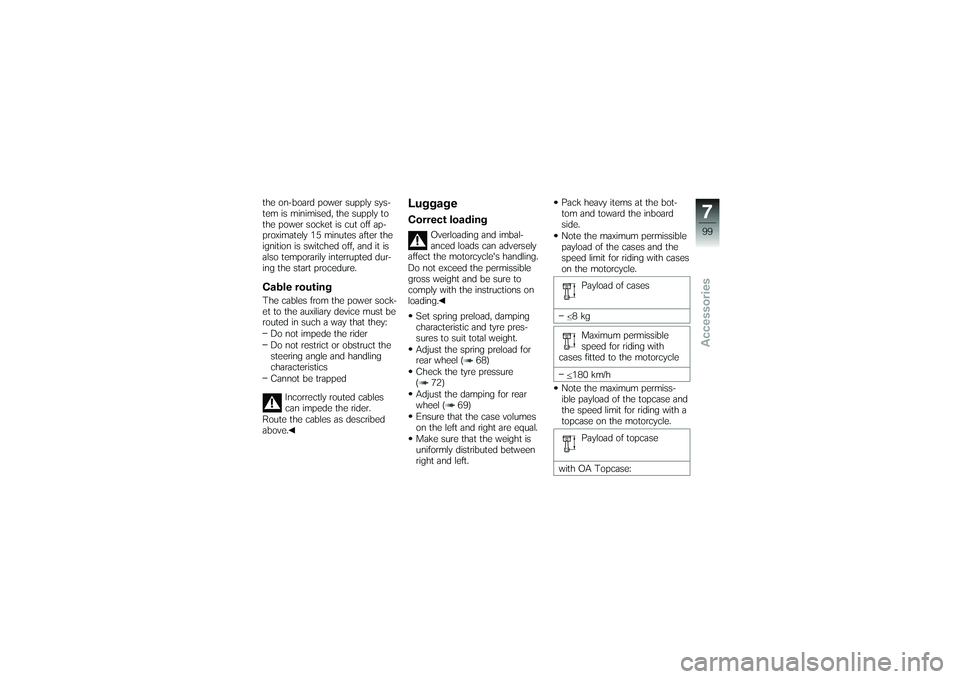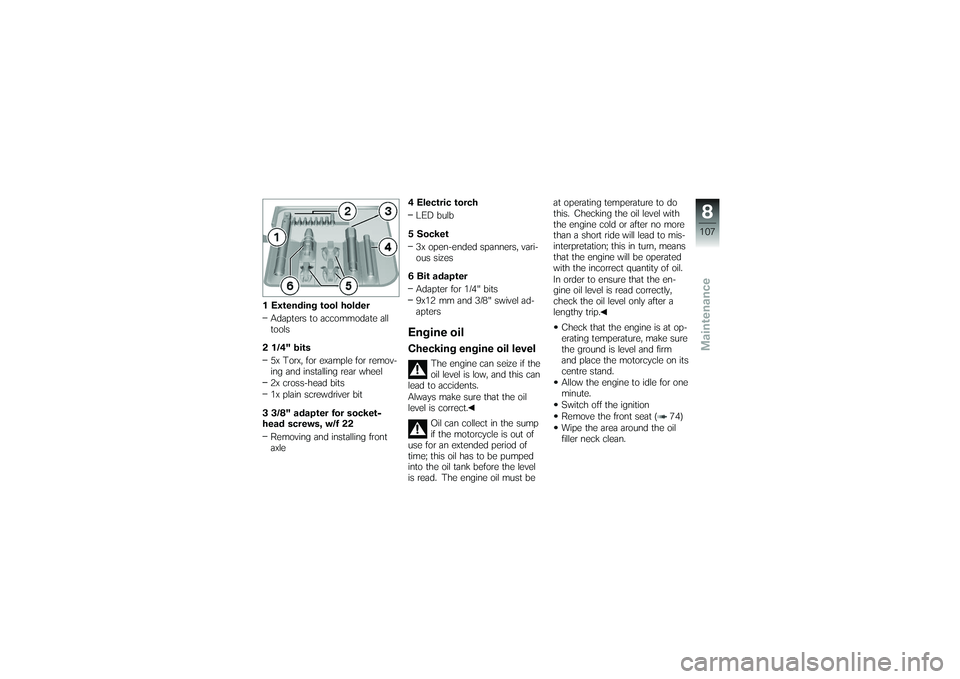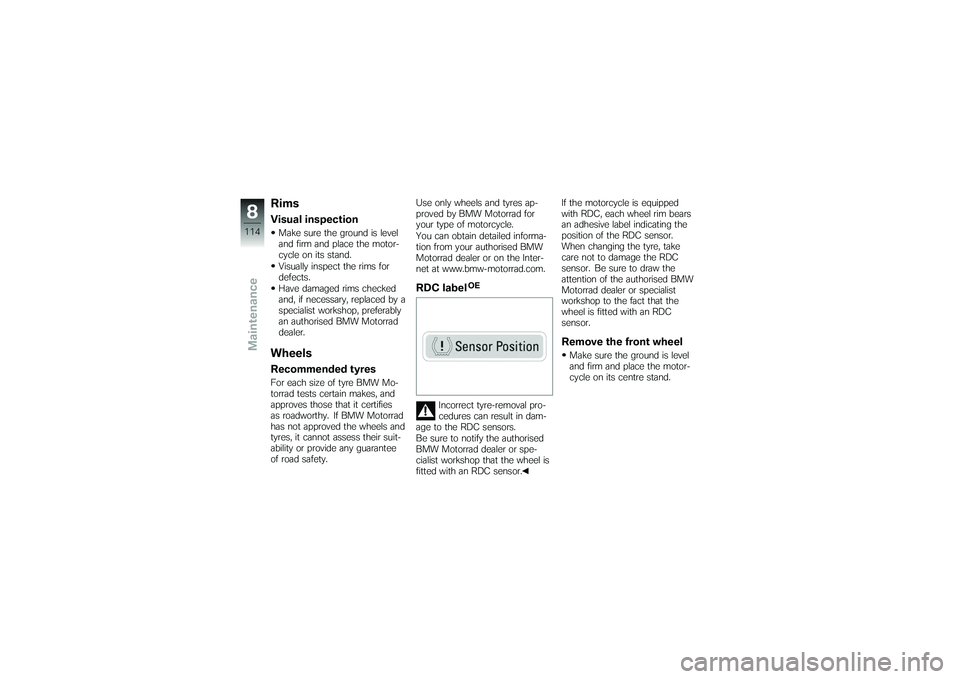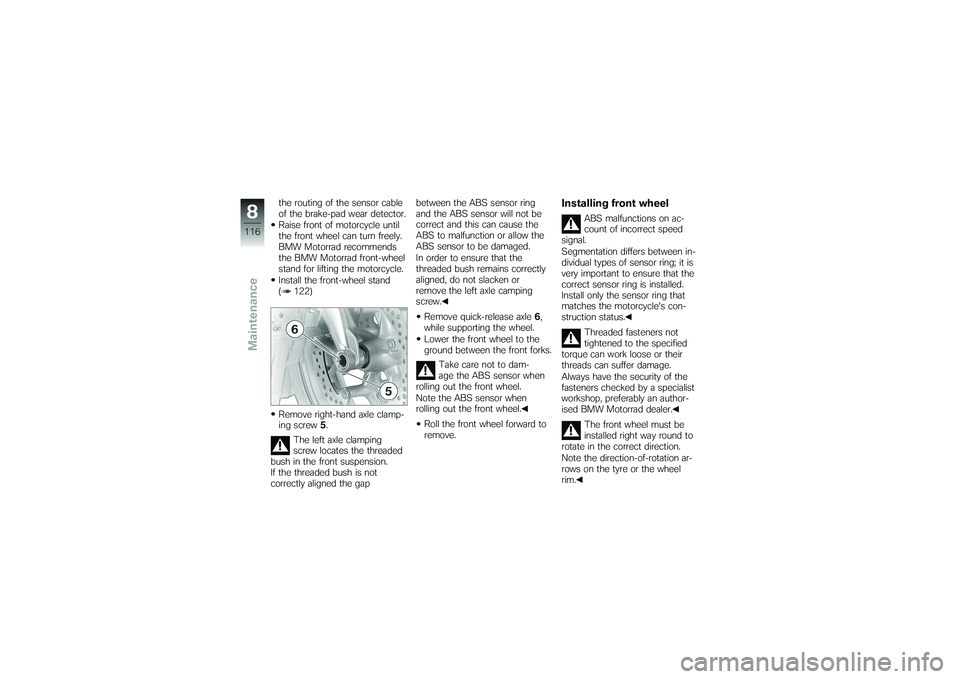Page 101 of 173

the on-board power supply sys-
tem is minimised, the supply to
the power socket is cut off ap-
proximately 15 minutes after the
ignition is switched off, and it is
also temporarily interrupted dur-
ing the start procedure.Cable routingThe cables from the power sock-
et to the auxiliary device must be
routed in such a way that they:Do not impede the rider
Do not restrict or obstruct the
steering angle and handling
characteristics
Cannot be trapped
Incorrectly routed cables
can impede the rider.
Route the cables as described
above.
LuggageCorrect loading
Overloading and imbal-
anced loads can adversely
affect the motorcycle's handling.
Do not exceed the permissible
gross weight and be sure to
comply with the instructions on
loading.
Set spring preload, damping
characteristic and tyre pres-
sures to suit total weight.
Adjust the spring preload for
rear wheel ( 68)
Check the tyre pressure
( 72)
Adjust the damping for rear
wheel ( 69)
Ensure that the case volumes
on the left and right are equal.
Make sure that the weight is
uniformly distributed between
right and left. Pack heavy items at the bot-
tom and toward the inboard
side.
Note the maximum permissible
payload of the cases and the
speed limit for riding with cases
on the motorcycle.
Payload of cases
8kg Maximum permissible
speed for riding with
cases fitted to the motorcycle
180 km/h
Note the maximum permiss-
ible payload of the topcase and
the speed limit for riding with a
topcase on the motorcycle.
Payload of topcase
with OA Topcase:
799zAccessories
Page 107 of 173
Maintenance
Maintenance
General instructions ................ 106
Toolkit . . . .......................... 106
Engine oil .......................... 107
Brake system, general . . . .......... 109
Brake pads . . . ..................... 109
Brake fluid ......................... 111
Clutch . . . .......................... 113
Tyres .............................. 113
Rims ............................... 114
Wheels . . .......................... 114
Front-wheel stand . . ............... 121
Bulbs .............................. 123
Jump starting . ..................... 131
Battery . . . .......................... 132
8105zMaintenance
Page 109 of 173

1 Extending tool holderAdapters to accommodate all
tools
2 1/4" bits 5x Torx, for example for remov-
ing and installing rear wheel
2x cross-head bits
1x plain screwdriver bit
3 3/8" adapter for socket-
head screws, w/f 22 Removing and installing front
axle 4 Electric torch
LED bulb
5 Socket 3x open-ended spanners, vari-
ous sizes
6 Bit adapter Adapter for 1/4" bits
9x12 mm and 3/8" swivel ad-
apters
Engine oilChecking engine oil level
The engine can seize if the
oil level is low, and this can
lead to accidents.
Always make sure that the oil
level is correct.
Oil can collect in the sump
if the motorcycle is out of
use for an extended period of
time; this oil has to be pumped
into the oil tank before the level
is read. The engine oil must be at operating temperature to do
this. Checking the oil level with
the engine cold or after no more
than a short ride will lead to mis-
interpretation; this in turn, means
that the engine will be operated
with the incorrect quantity of oil.
In order to ensure that the en-
gine oil level is read correctly,
check the oil level only after a
lengthy trip.
Check that the engine is at op-
erating temperature, make sure
the ground is level and firm
and place the motorcycle on its
centre stand.
Allow the engine to idle for one
minute.
Switch off the ignition
Remove the front seat ( 74)
Wipe the area around the oil
filler neck clean.
8107zMaintenance
Page 112 of 173
Visually inspect the left and
right brake pads to ascertain
their thickness. Viewing direc-
tion: Between wheel and front
fork toward the brake caliper.Brake-pad wear limit,
front
min 1 mm (Friction pad only,
without backing plate)
The wear indicators
(grooves) must be clearly
visible.
If the wear indicating mark is no
longer clearly visible: Have the brake pads replaced
by a specialist workshop,
preferably an authorised BMW
Motorrad dealer.
Checking rear brake pad
thickness
Brake pads worn past
the minimum permissible
brake-pad thickness can cause
a reduction in braking efficiency
and under certain circumstances
they can cause damage to the
brake system.
In order to ensure the dependab-
ility of the brake system, do not
permit the brake pads to wear
past the minimum permissible
brake-pad thickness.
Make sure the ground is level
and firm and place the motor-
cycle on its stand.
8110zMaintenance
Page 116 of 173

RimsVisual inspectionMake sure the ground is level
and firm and place the motor-
cycle on its stand.
Visually inspect the rims for
defects.
Have damaged rims checked
and, if necessary, replaced by a
specialist workshop, preferably
an authorised BMW Motorrad
dealer.WheelsRecommended tyresFor each size of tyre BMW Mo-
torrad tests certain makes, and
approves those that it certifies
as roadworthy. If BMW Motorrad
has not approved the wheels and
tyres, it cannot assess their suit-
ability or provide any guarantee
of road safety.Use only wheels and tyres ap-
proved by BMW Motorrad for
your type of motorcycle.
You can obtain detailed informa-
tion from your authorised BMW
Motorrad dealer or on the Inter-
net at www.bmw-motorrad.com.
RDC label
OE
Incorrect tyre-removal pro-
cedures can result in dam-
age to the RDC sensors.
Be sure to notify the authorised
BMW Motorrad dealer or spe-
cialist workshop that the wheel is
fitted with an RDC sensor. If the motorcycle is equipped
with RDC, each wheel rim bears
an adhesive label indicating the
position of the RDC sensor.
When changing the tyre, take
care not to damage the RDC
sensor. Be sure to draw the
attention of the authorised BMW
Motorrad dealer or specialist
workshop to the fact that the
wheel is fitted with an RDC
sensor.
Remove the front wheelMake sure the ground is level
and firm and place the motor-
cycle on its centre stand.
8114zMaintenance
Page 117 of 173
Remove screws1on left and
right.
Pull the front mudguard for-
ward to remove. Once the calipers have
been removed, there is
a risk of the brake pads being
pressed together to the extent
that they cannot be slipped back
over the brake disc on reas-
sembly.
Do not operate the handbrake
lever when the brake calipers
have been removed.
Remove securing screws 2of
the left and right brake calipers. Force the brake pads slightly
apart by rocking brake
calipers
3back and forth A
against brake discs 4.
Mask off the parts of the wheel
rim that could be scratched in
the process of removing the
brake calipers.
Carefully pull the brake calipers
back and out until clear of the
brake discs.
When removing the left brake
caliper, take care not to dam-
age the ABS sensor cable.
When removing the right brake
caliper, take care not to alter
8115zMaintenance
Page 118 of 173

the routing of the sensor cable
of the brake-pad wear detector.
Raise front of motorcycle until
the front wheel can turn freely.
BMW Motorrad recommends
the BMW Motorrad front-wheel
stand for lifting the motorcycle.
Install the front-wheel stand
( 122)
Remove right-hand axle clamp-
ing screw5.
The left axle clamping
screw locates the threaded
bush in the front suspension.
If the threaded bush is not
correctly aligned the gap between the ABS sensor ring
and the ABS sensor will not be
correct and this can cause the
ABS to malfunction or allow the
ABS sensor to be damaged.
In order to ensure that the
threaded bush remains correctly
aligned, do not slacken or
remove the left axle camping
screw.
Remove quick-release axle 6,
while supporting the wheel.
Lower the front wheel to the
ground between the front forks.
Take care not to dam-
age the ABS sensor when
rolling out the front wheel.
Note the ABS sensor when
rolling out the front wheel.
Roll the front wheel forward to
remove.
Installing front wheel
ABS malfunctions on ac-
count of incorrect speed
signal.
Segmentation differs between in-
dividual types of sensor ring; it is
very important to ensure that the
correct sensor ring is installed.
Install only the sensor ring that
matches the motorcycle's con-
struction status.
Threaded fasteners not
tightened to the specified
torque can work loose or their
threads can suffer damage.
Always have the security of the
fasteners checked by a specialist
workshop, preferably an author-
ised BMW Motorrad dealer.
The front wheel must be
installed right way round to
rotate in the correct direction.
Note the direction-of-rotation ar-
rows on the tyre or the wheel
rim.
8116zMaintenance
Page 119 of 173
There is a risk of damaging
parts of the front brake,
particularly the BMW Motorrad
Integral ABS, in the course of the
procedure described below.
Take care not to damage the
brake system, in particular the
ABS sensor with cable and the
ABS sensor ring.
Take care not to dam-
age the ABS sensor when
rolling in the front wheel.
Note the ABS sensor when
rolling in the front wheel.
Roll the front wheel into posi-
tion in the front suspension. Raise the front wheel, insert
quick-release axle
6and tight-
en to specified torque.
Quick-release axle in
threaded bush
50 Nm
Tighten right axle clamping
screw 5to the specified tight-
ening torque.
Clamping screw for
quick-release axle in
wheel carrier
19 Nm
Remove the front-wheel stand. Install securing screws
2on
left and right and tighten to
specified tightening torque.
Front brake caliper to
wheel carrier
30 Nm
8117zMaintenance